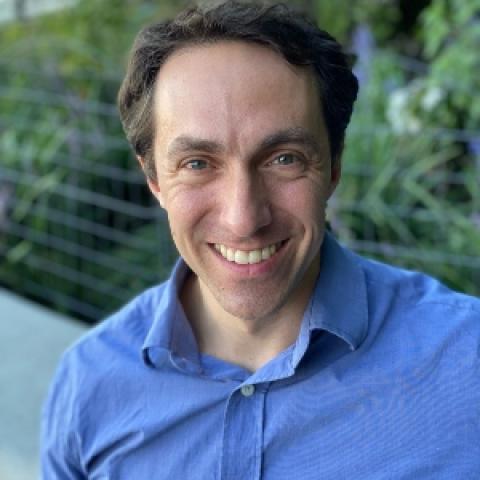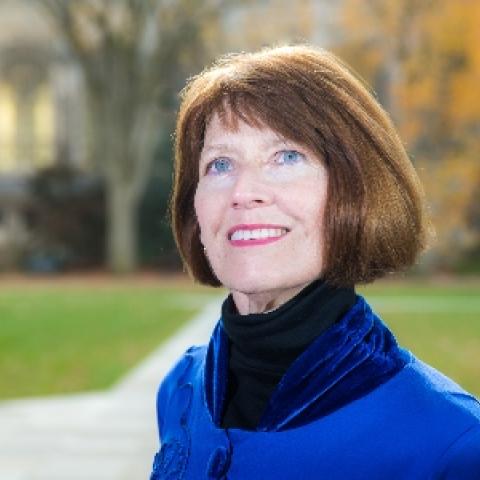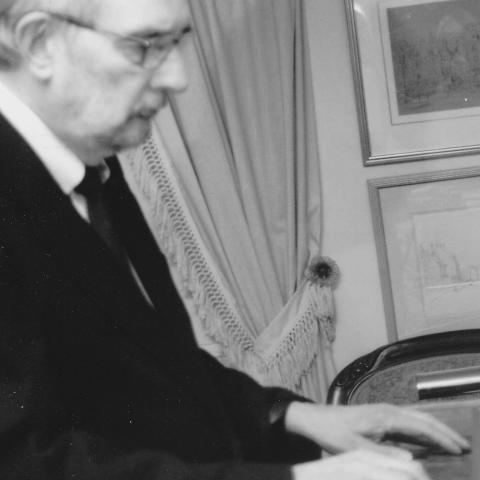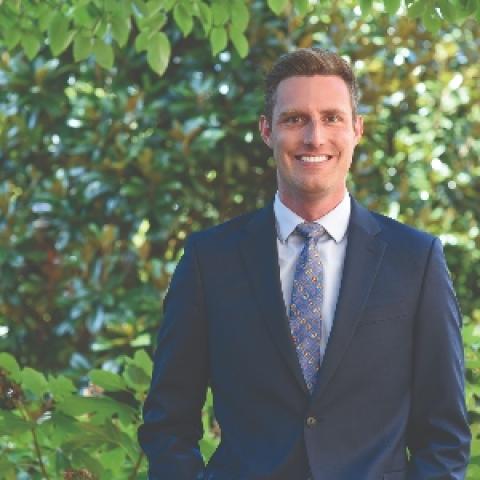Joyce Johnson Robinson is a past editor of The Diapason.
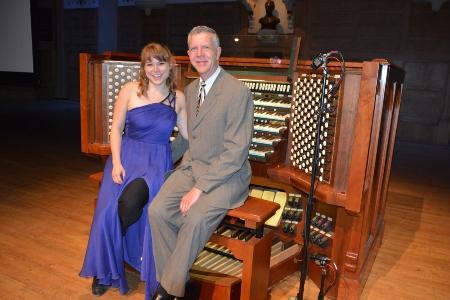
Katelyn Emerson is a member of The Diapason’s inaugural 20 Under 30 (2015) class, an honor bestowed prior to receiving her undergraduate degrees from Oberlin. She had already earned top prizes in numerous competitions in the United States, France, and Russia. She teaches in her private studio and performs nationally and internationally. Katelyn Emerson is represented in North America by Karen McFarlane Artists, Inc.
Katelyn, what were some of the first instruments you played? What led you to prefer the organ?
Growing up, I was drawn to voice, piano, flute, and organ. Singing was integral to my childhood as my whole family sang in a church choir and my older brother, Andrew, and I both sang in the Sandpipers Seacoast Children’s Chorus, in Portsmouth, New Hampshire.
When Andrew turned ten, he began piano lessons. Naturally, as a six-year-old enamored with everything he was doing, I began to sightread through his piano music, and my parents sought a piano teacher to spare them from the cacophony coming from the keyboard—and so that I wouldn’t learn bad habits.
Four years later, all I wanted for my birthday was flute lessons as I had watched my mother play and loved the sound of the instrument. Flute and voice ultimately allowed me to join both local and all-state youth symphonies and choruses.
Dianne Dean, director of the Sandpipers Chorus, first introduced me to the possibility of playing the organ. I had plunked out a hymn or two at my parents’ church but thought this imposing instrument out of reach for a small girl. However, Dianne had been instrumental in founding the Young Organists’ Collaborative, an organization that introduces young people to the pipe organ and funds their early studies. She encouraged me to audition for a scholarship, and upon receiving it, I studied piano, flute, and organ through high school.
The “lightning bolt” moment was during the Symphony No. 3 in C Minor, opus 78, of Camille Saint-Saëns. I was principal flutist of the Portland (Maine) Youth Symphony Orchestra, playing at the heart of the ensemble while my then organ teacher, Ray Cornils, played the Kotzschmar organ in Merrill Auditorium. There had been no time to rehearse with the organ prior to the concert, so those brilliant C-major chords of the final movement came as a complete shock. I realized the organ could be all the musical instruments I loved—and that it could even keep pace with a full symphony orchestra! This could be my instrument.
Tell us about your experience with the Young Organists’ Collaborative.
The Young Organists’ Collaborative (YOC) was founded in 2001 in Portsmouth, New Hampshire, when a new Létourneau organ was installed in Saint John’s Episcopal Church. When Bishop Douglas E. Theuner came to bless the instrument, he donated $1,000 seed money with the charge to find a way to bring young people to play the pipe organ. Chosen students received a year’s worth of lessons and a small stipend for shoes or scores. Today, students come from around the seacoast—Maine, New Hampshire, Massachusetts, etc.—and are paired with an approved local teacher who can help find practice spaces. They are required to play at the end-of-year recital and are invited to take part in a masterclass with a professional organist partway through the year. The YOC can fund up to three years of study and offers additional scholarship competitions.
I received one of these scholarships in 2005 and began studies with Abbey Hallberg Siegfried, who worked at Saint John’s. When she went on maternity leave a year later, Abbey connected me with Ray Cornils, municipal organist of Portland, Maine, whose teaching included practice techniques, patience, and good humor that form the foundation of my playing and teaching.
When and where did you give your first recital? What did you play?
It’s difficult to recall my first recital! I do remember my first organ masterclass vividly, when I had only been studying for about six months. This class, sponsored by the YOC, was with Ray Cornils, whom I was meeting for the first time. I played the “Prelude and Fugue in B-flat Major” from the Eight Little Preludes and Fugues attributed to Bach. After I played through the work in its entirety, Ray quietly asked if I realized which pedal note I had missed in the prelude. While I can’t remember now which note it was, I do remember him guiding me through the process of identifying the reason for the mistake. That detective work set the standard for how I problem-solve in my own practice and how I work with my students to do the same.
You earned your degrees at Oberlin and subsequently studied in France and Germany. How did each of these experiences form you?
During my first semester at Oberlin, my assigned teacher, James David Christie, went on sabbatical. While usually a cause for chagrin, this was an extraordinary stroke of luck: he swapped positions with Olivier Latry.
I have always learned repertoire quickly, but Professor Latry’s demands put me into high gear. At least one new piece each week was expected, which meant that I had expended the music I had prepared over the summer halfway through the semester. After panic-learning Duruflé’s Prélude et fugue sur le nom d’Alain in five days, I finally mastered “the back burner”; with two dozen or so pieces in progress at once, each at a different stage of learning, a new one would hit the “lesson-ready” point just at the right moment. Professor Latry also expanded my arsenal of practice techniques, and I would credit nearly all of my inherited practice methods to him and Ray Cornils.
Professor Christie’s preferred pedagogical approach was almost perfectly opposite: rather than covering new music every week, he preferred a lengthier study of style, working through a half-dozen pieces over the course of a semester to develop deeper understanding that could be applied to other music of that genre. I have grown to appreciate this more than I did as a teenager and to balance learning notes quickly with understanding and translating the music.
My love affair with all things French had begun only two years before university, and fortunately additional academic scholarship was available if I pursued the double degree program at Oberlin (a Bachelor of Arts and a Bachelor of Music after five years), so French language and literature was the natural choice. I remember asking Professor Latry about studies at the Conservatoire de Paris within our first few lessons together, likely to his amusement!
My first solo trip abroad was in 2011, between my freshman and sophomore years, for the last iteration of the Summer Institute for French Organ Studies, led by Jesse Eschbach and Gene Bedient. Aided by a scholarship, I traveled to Poitiers and then Épernay, wondering if I could handle being alone abroad. Wandering the cobblestones of Poitiers, reveling in that 1787 Clicquot, and then the 1869 Cavaillé-Coll of Église Notre-Dame in Épernay, and getting to know the other students from Indiana, Utah, and Canada, I discovered that I thrived on travel.
During my sophomore year at Oberlin, Marie-Louise Langlais came to teach. In contrast to Professor Christie’s detail-oriented teaching, Madame Langlais emphasized beautiful broad lines, Wagnerian long phrases, and propelling the music forwards no matter what.
At Oberlin, one of my most impactful teachers was not an organ professor. David Breitman remains head of the historical performance department and teaches fortepiano. After I carelessly ran through a Mozart sonata in one of my first fortepiano lessons, I remember him asking, “Now, this is an opera. Tell me about the first character. What else was Mozart working on while composing this?” Ray Cornils had planted the first seeds of exploring musical character in my mind (“If you met this piece walking down the street, what would it look like? How would she feel? Where would he be going?”), but I hadn’t applied this inquisitive curiosity more broadly. Professor Breitman’s similarly Socratic method of teaching was a continuation of Ray’s. Neither teacher ever dictated interpretation. Instead, they posed questions that led a student to make informed decisions and arrive at possible conclusions themselves through a contextualization and personification of music that has become a cornerstone of my playing and pedagogy.
The formative experiences and broad education I received from Oberlin continued to feed my curiosity. I took classes in psychology, astronomy, anthropology, rhetoric, French literature, and more.
Upon graduating, I won a Fulbright scholarship to study in Toulouse. I documented a fraction of that year in France on my blog (katelynemerson.wordpress.com), but spent most of it on road trips to see untouched instruments in the countryside, locked into Saint-Sernin at night, scrambling for practice time, being clapped at because nobody had mentioned a noon Mass, stopping by the marché for bread and a bottle of wine for a picnic, and showing up at the Conservatoire to discover there was another strike and it was closed. Life had a different pace. Concerts were a train ride away, I performed on instruments sometimes wonderful and sometimes frightful, and I met brilliant colleagues and lifelong friends.
My teachers in Toulouse, Michel Bouvard and Jan Willem Jansen, once again revealed how contrasting teaching styles can enrich study. With Michel Bouvard, I delved into the French Romantic, allowing the instruments to inform how the repertoire can really be played. His relaxed technique and unpretentious approach to this music gave it space to sing. Jan Willem Jansen had extraordinary attention to detail. After hearing me play the “Allein Gott” trio from the Clavierübung, he rightfully informed me that the fourth and fifth sixteenth notes of measure 27 had rushed. I doubt my ears will ever be so attuned to proportion, but I still strive for it nonetheless!
As my year in France concluded and I prepared to pursue further graduate studies, I was offered the associate organist and choirmaster position at the Church of the Advent in Boston, which I simply couldn’t turn down. I had worked with music director Mark Dwyer for several months while at Oberlin and was in awe of the program, liturgy, and choirs. Mark remains a dear friend, colleague, and teacher, and his attention to detail emphasized the importance of every part of music—from note to silence.
The itch to live abroad is difficult to scratch, so I’m particularly grateful to make a living based on travel! Having heard that Ludger Lohmann would retire in 2020, I applied for a German Academic Exchange Scholarship (DAAD) to pursue the Master Orgel at the Hochschule für Musik und Darstellende Kunst in Stuttgart. It broke my heart to leave Boston but I looked forward to two years in Germany.
Navigating life in France had been fairly easy given my comfort with the language. I had enough German to be dangerous—enough so that people assumed I understood. Thankfully, I avoided extreme disaster, realized the meaning of halb zwei in time not to miss my lessons, and discovered the delicacies of southern German cuisine. Lessons with Ludger perfectly balanced churning through new repertoire, exploring historical context, and receiving a list of sources (often primary) to consult. When the pandemic disrupted studies, we met at his beautiful home on the border of Switzerland to indulge in cake and then play and discuss Reger on the three-manual tracker in his living room.
I have been extraordinarily fortunate to have mentors, human and instrumental, that have each shared perspectives and ideas for ways to approach both music and life. This is but a small sample of those who have shaped my understanding, and I hope those not mentioned will still feel my appreciation and forgive the oversight, due solely to lack of space.
How has your knowledge of foreign languages and your living abroad given you insights into the music of those countries’ composers?
Music is inevitably tied to the social, historical, and cultural context in which it was conceived, even while its nature as organized sound allows it to have meaning outside a single context. My understanding of different languages and sensitivity to ways of comportment have helped me to get to know people all over the world, and I continually strive to connect with and understand them better. As an interpreter, I try to delve into the composer’s influences as well as my own, linking both to the present listeners as we undertake the aural tour of emotive depth and structure that is music performance. To do this, I strive to learn as much as I can of the time, place, and people that surrounded the music’s conception to make interpretative decisions that both link and are drawn from the past and present. The more I learn and study, the richer and more complex these relationships become, which results in further exploration and endless excitement!
Tell us about your recordings—those already made, and those planned for the future.
I have released two recordings on the Pro Organo label, working with Fred Hohman. The first of these, part of the prize package from the American Guild of Organists’ 2016 National Young Artists Competition in Organ Performance, was recorded on the glorious 1935–1936 Aeolian-Skinner at the Church of the Advent in Boston where I was working. These winners’ CDs are typically variety programs, so I sought to showcase how this liturgical instrument can play a variety of repertoire brilliantly, with music by Bruhns, J. S. Bach, Mendelssohn, François Couperin, Alain, Vierne, Tournemire, Thierry Escaich, and Howells. The album title, Evocations, comes from Escaich’s Évocation III (this was its first CD recording). Two years later, Andover Organ Company approached me about a new recording on their magnum opus, Opus 114, at Christ Lutheran Church in Baltimore in honor of their company’s seventieth anniversary. For this CD, Inspirations, I played Rachel Laurin’s Finale, opus 78 (this was the first recording), Horatio Parker, Rheinberger, Buxtehude, Bairstow, de Grigny, Langlais, and Duruflé.
Over the last two years, recording has become more essential than ever. I now have my own video and audio recording equipment and, while none of it equals commercial-level recording equipment, I can use it to pre-record recitals for venues that want to “premiere” the recital on YouTube or Vimeo, particularly if they don’t have their own equipment, and I can also make recordings for my channels. I have a huge “dream list” of instruments on which I would like to record CDs and frequently tweak ideas for programs on them. One idea would juxtapose commissions of living composers with previously composed repertoire related by inspirational source or another contextual consideration—an idea that will hopefully come into being in the next few years!
Who are some of your favorite composers?
My favorite composers are those who wrote the music I’m currently playing! Similarly, the best organ in the world is the one on which I will perform next or am currently playing, and the best piece in the world is the one that’s on the music desk right now. While this might seem to be a cop-out, it’s a simple truth: we play music better when we like it—so we must like what we are working on in order to play it well.
When push comes to shove, I am happiest playing a variety of music. My music bag currently contains music by Parry, Bach, Taylor-Coleridge, Dupré, Demessieux, Reger, Sowerby, Alcock, Laurin, Duruflé, Price, Widor, Whitlock, Franck, and Scheidemann, as well as a few others.
Tell us about your teaching.
After beginning at Oberlin, I was asked to help guide incoming students as an academic ambassador, explaining the sometimes-overwhelming collegiate administration and helping them to choose courses that would feed their curiosity. I tutored French, music theory, and organ at Oberlin, and taught music theory at the local community music school.
Since graduating, I have continued teaching, both privately and in masterclass and lecture settings, holding general question-and-answer sessions that follow tangents of interest as well as structuring courses that focus on specific topics. I enjoy connecting sometimes disparate ideas and exploring possibilities, discussing why decisions can be made this way or that, and, above all, searching for the many nuanced ideas that make an individual “tick.”
My teaching studio is loosely divided into three groups: those working on interpretation, those seeking to improve practice strategies, and those learning about injury prevention or working to recover from injury. Of course, most are tackling all three!
Interpretation, at its core, requires working with ideas, examining options, and then seeking physical means to translate them convincingly into sound. Since we organists cannot modulate volume with touch as pianists can, nor can we swell or diminish sound via the breath of wind or the bows of string players, much of our playing is about manipulating smoke and mirrors to turn our intention into aural reality. Since we can now so easily record ourselves, I hold even greater admiration for how players listen in the moment to what is going on, and particularly for how each of my students has a different way of perceiving the sounds swirling around them. Couple this with learning about the context of the composer, their influences, the instruments they may have known, and the time and place in which the piece was composed, and we have rich, unique “readings” of the repertoire that can link to the interests of any student, all while we explore techniques to help bring that perspective to reality.
Time is short for everybody, and practice must be as efficient as possible. Having studied with excellent teachers of practice methods and having experienced fairly limited practice time during study and travel, I continue to explore ways to break down repertoire for efficient practice. I often make a game of turning difficult sections into manageable chunks, isolating them from the context that can distract from them. Sometimes, I encourage a student to leave it in that “practice mode” for days or even weeks, which allows the subconscious mind to digest novel movement. The best part of this technique is the excitement with which a student brings me new ideas for this “game,” ideas that I can then share with others when similar sections come up!
Surveys indicate that somewhere between 60% and 90% of professional musicians in the United States have experienced some kind of performance-related musculoskeletal disorder, most often due to overuse. The enthusiasm with which the work of pedagogues such as Roberta Gary and Barbara Lister-Sink has been received, the many stories shared by colleagues and students, and both the unnatural perch on the organ bench and the similarity in how organists use their hands and upper body to that of pianists all make me suspect that this prevalence is much the same in organists.
At age fourteen, I developed bilateral tendonitis in my wrists and forearms. Giving music up was not an option, so I undertook technical retraining with Arlene Kies, late professor of piano at the University of New Hampshire. Arlene helped me to completely rebuild my technique, as I had had almost no technical training in my six years of study. Through her work and that of my mother, a certified hand therapist and occupational ergonomist, I regained my ability to make music and developed a deep respect for my body. By paying attention to its abilities and limitations, I overcame many flare-ups throughout the next decade (including several during competitions).
This firsthand experience with how playing and practice techniques can couple with contributing factors for tragic consequences inspired me to deepen my understanding of these complex issues so I can work with musicians, particularly organists, to prevent injury and, when injury happens, collaborate with the individual and their medical specialists to work towards recovery. We discuss healthier practice techniques that utilize mental involvement to balance out physical repetition that can lead to overuse, review postural considerations, and discuss ways to give whatever part of the body that is most at risk a little relief, whether avoiding using force when opening jars or cans or making small changes to computer and office workstations. If a student is experiencing pain or discomfort or is recovering from an injury, I always strongly recommend that they work with a medical professional for treatment in addition to exploring adjustments at their instrument.
Being a teacher and being a student go hand in hand. We teach ourselves while in the practice room, but the added variable of joining another person on their journey of learning means that we are continually exposed to different vantage points and ideas.
How have things been for you during the time of covid?
In spring of 2020, I was based in Germany, but, when rumors that international borders might close began to proliferate, I was on tour in the United States. Fortunately, I made it back to Baden-Württemberg just a few days before flights were grounded. Despite the restrictions, I was able to complete my final semester of my master’s study, performing a program of Froberger, Messiaen, and Reger to an audience of fourteen (including the jury) in the Stuttgart Musikhochschule’s concert hall. That summer was spent waiting and then moving quickly as restrictions changed, but my husband, David Brown, who then worked for Glatter-Götz Orgelbau while I completed my studies, and I managed to return to the United States in September 2020 so he could resume work at Buzard Pipe Organ Builders.
Many people I have spoken with have described challenging months, yet they have almost always also shared silver linings like cherishing time with family and friends or pursuing new projects. My 2020 and 2021 were the same: over seventy concerts were postponed (incredibly, very few canceled entirely), which broke my heart, but my time was filled with writing articles, teaching in person and over Zoom (which I had been doing while traveling, even before 2020!), and learning new repertoire. I also took a course in occupational ergonomics to support my teaching of injury prevention. The world felt like it was on hold for so long, but hope was always on the horizon with wonderful events scheduled for the future—many of which are taking place now!
What are some of your hopes and plans for the future?
We live in such an exciting time. No previous generation has had so much information at their fingertips, just a click away. The work of thousands of previous performers and researchers—and the life experiences of millions of human beings—is there for our perusal and for us to build on.
It is incredibly easy to pour through stacks of music and literature, both physically and online, and I’m constantly noting repertoire that I want to learn and share with people. Including some of this less-familiar music in programs requires that I show why this music matters and why audiences should care about it. Without knowing the context or inspiration of a particular piece, how could a listener attending a concert after a busy workday be expected to respond to it? They often have nothing to hold onto, particularly with a longer or more esoteric work, so why should they come back to hear more? Highly aware of this, I seek to share my passion for each piece, proposing some ways through which to relate to it. Connecting a particular piece of music with the heart of the listener has become one of my highest performance priorities.
I would also like to help to evolve the definitions of success for us musicians and organists. I have spoken with so many who did not experience their “big break” before age thirty and who desperately strive to feel successful. We are so often told what success should look like that we can no longer hear our internal voice showing us how our unique skills could create something quite different. This leads to discouragement, depression, and sometimes a heartbreaking lack of self-compassion. I tackle this with my students and work with musicians in all stages of life to help curate their unique careers and pursue whatever they hope to achieve. My own path has been rather unusual, with several gap years that opened Europe and Asia for performance and study, and with my primary income from performing and teaching. The latter is integral to who I am as a person and a musician, as is writing articles that continue conversations about a diverse range of ideas.
While I don’t yet have the answer to this challenge, I try to work with my students and colleagues to explore ways to find our place in a world large and varied enough for all of us. We all may play the pipe organ, but our unique backgrounds—culture, language, family, and everything else—cause us to approach life and this instrument so vastly differently that each of us have the potential to fill a gap that the field didn’t even know was there.
It just takes listening.
Thank you, Katelyn!
Katelyn Emerson’s website: katelynemerson.com

